Bali has many beautiful temples, but Tirta Empul Temple stands out as one of the most sacred and culturally significant. Nestled in Tampaksiring, this ancient Hindu water temple is renowned for its holy spring water. It is believed to have purification powers, where locals and travelers participate in the Melukat cleansing ritual.
“Bahasa Indonesia: Tempat Wisata Pura Tirta Empul Bali.“
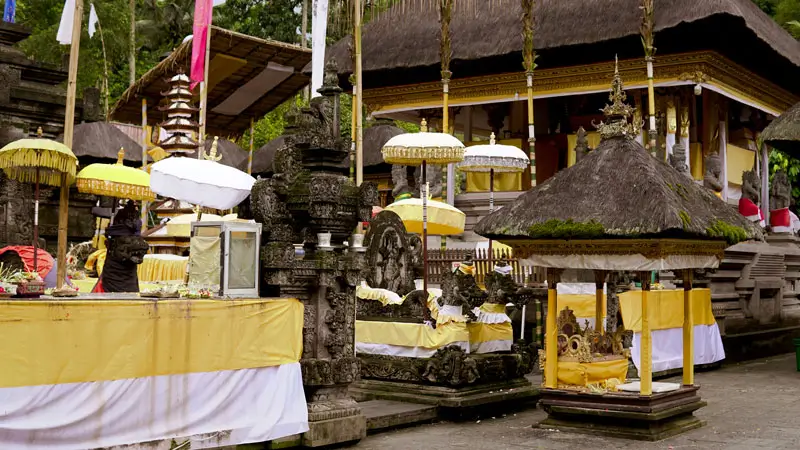
Whether you’re seeking spiritual renewal, fascinated by Balinese Hindu culture, or simply looking to explore one of Bali’s oldest temples, this guide covers everything you need to know before your visit.
Table of Contents[Hide][Show]
Is Tirta Empul Temple in Bali Worth Visiting?
Absolutely! Tirta Empul Temple is worth visiting during your vacation in Bali due to its spiritual significance, cultural heritage, and unique Melukat purification ritual.
As one of Bali’s most important water temples, it offers an intensely immersive cultural experience, beautiful architecture, and the opportunity to witness traditional Hindu ceremonies.
Why Should You Visit Holy Spring Water Temple?
- Experience the Melukat purification ritual, a sacred cleansing ceremony in holy spring water.
- Explore a temple complex built in 962 AD, which is deeply rooted in Balinese history and mythology.
- Observe Balinese Hindu ceremonies, including the Piodalan temple anniversary.
- Enjoy a peaceful atmosphere surrounded by tropical greenery and traditional courtyards.
Melukat Ritual at Tirta Empul Temple: What to Expect
What Is the Purification Ritual at Tirta Empul Temple?
The Melukat purification ritual (YouTube) at Tirta Empul is a Balinese Hindu cleansing ceremony performed in the temple’s sacred spring waters. According to tradition, this ritual purifies the body, mind, and soul, removing negative energy and bringing spiritual renewal.
Can Non-Hindus Take Part in the Melukat Ritual?
Yes, non-Hindus are welcome to participate in the Melukat ritual. However, it is essential to approach the ceremony respectfully and follow the proper steps to honor its spiritual significance.
How Can Non-Hindus Join the Melukat Ritual?
What to Wear for Melukat?
For the Melukat purification ritual, visitors must wear a sarong and a sash, which are required for all participants. Women may also wear a kebaya (traditional blouse), which is not mandatory. Dressing modestly is essential, as this is a sacred Hindu ritual.
- Sarong & Sash – Required for all participants (available for rent or provided at the temple entrance).
- Kebaya for Women – Optional, but recommended for a more traditional experience.
- Covered Shoulders – Wear less revealing clothing to show respect.
Tip: If you don’t have the proper clothing, you can get sarongs and sashes for free at the temple entrance.
How to Prepare for the Melukat Ritual

To fully experience the Melukat purification ritual, it is essential to come prepared.
- Bring an Offering – A canang sari (small offering) is required and can be purchased at temple stalls.
- Pack Essentials: Bring a change of clothes, a towel, a plastic bag for wet items, kamen (traditional cloth), and an extra sash.
- Show Respect – Be sincere during the ceremony and follow the temple rules.
Step-by-Step Ritual Process
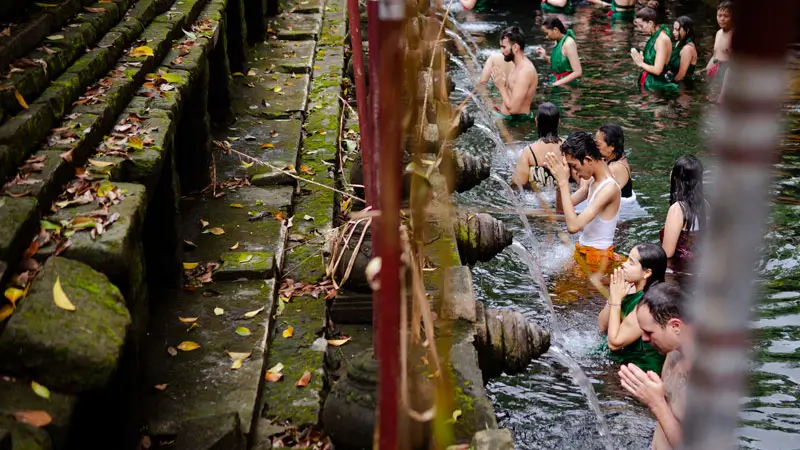
- Initial Bathing – Rinse off at the designated area before entering the purification pools.
- Offering & Prayer – Present your canang sari and offer a short prayer before stepping into the water.
- Purification at the Fountain – Move from one sacred spring to another. Pour holy water over your head as you pray for spiritual cleansing.
- Final Prayer – After completing the ritual, offer a final prayer at the main shrine for blessings.
Tip: If you’re unsure what to do, the temple staff or local guides can help you follow the ritual correctly.
Bali Water Temple Layout & Sacred Areas
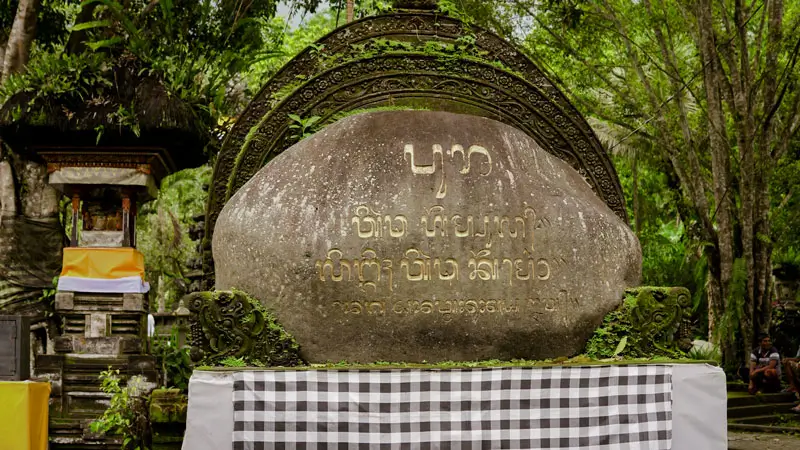
Tirta Empul Temple showcases traditional Balinese architecture and holds deep spiritual significance. The water temple complex has three main sections, each essential in Hindu rituals and purification.
Jaba Pura (Outer Courtyard & Entrance)
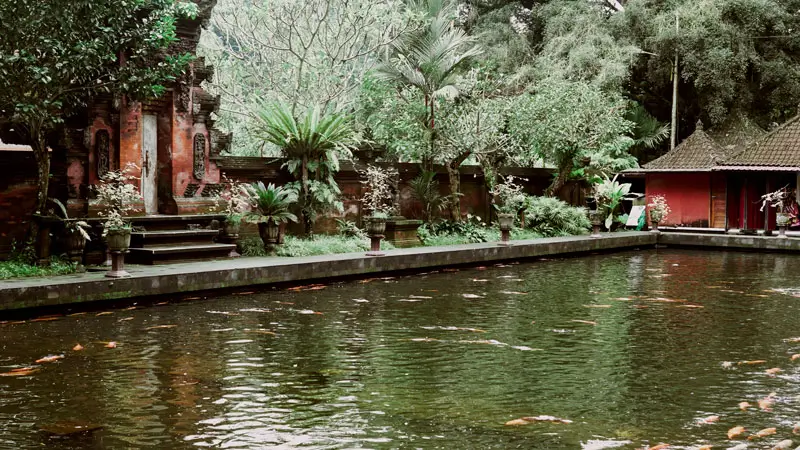
This is the first area visitors enter through the temple’s ornate main gate.
- Wantilan Pavilion – A gathering space for worshippers and visitors preparing for rituals.
- Koi Pond & Greenery—This serene spot, surrounded by tropical plants, is perfect for quiet reflection before exploring further.
Jaba Tengah (Purification Pools & Holy Fountains)
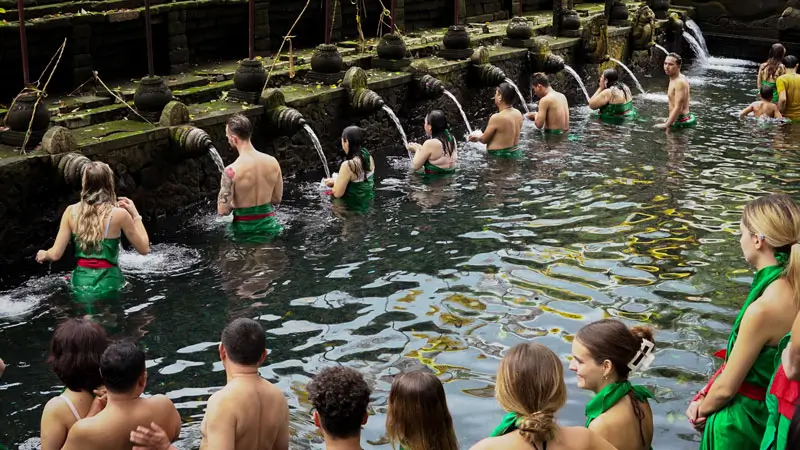
This section is the heart of Tirta Empul Temple, Bali, where the Melukat purification ritual occurs.
There are two large purification pools filled with crystal-clear, waist-deep water. Additionally, 26 holy fountains line the pools, each serving a specific spiritual purpose:
- Tirta Sudamala – Cleanses the soul.
- Tirta Penglukatan – Washes away negative energy.
- Tirta Panegtegan – Grant’s inner strength.
Restricted Fountains in Tirta Empul Sacred Water Temple
- Tirta Pengentas & Tirta Pabersihan are reserved exclusively for Pitra Yadnya, a Hindu death ritual.
- If used accidentally, restarting the purification process from the first fountain is recommended.
Jeroan (Inner Sanctuary & Sacred Spring)
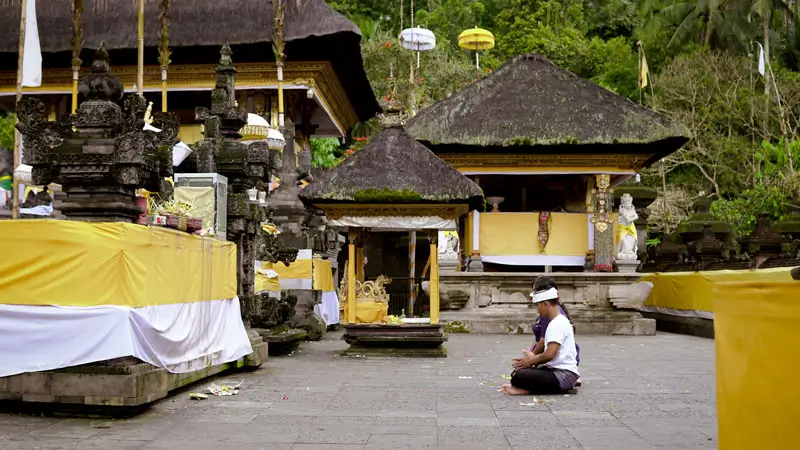
This is the holiest part of the temple, where worshippers pray after completing the purification ritual.
- The Sacred Spring – A natural water source that has flowed for centuries. It symbolizes purity and blessings.
- Main Shrines & Prayer Areas – A peaceful space for Hindu offerings, meditation, and reflection.
Best Time to Visit Tirta Empul Temple
The best time to visit Tirta Empul Purification Temple depends on whether you prefer a calm experience or wish to witness sacred ceremonies.
Best Time for a Peaceful Visit
- Weekday mornings (before 10 AM) are ideal for avoiding crowds.
- April to October (Dry Season) offers sunny weather, perfect for sightseeing and photography.
- November to March (the rainy season) sees fewer visitors, but paths can be slippery—bring an umbrella or raincoat.
Best Time for the Melukat Purification Ritual
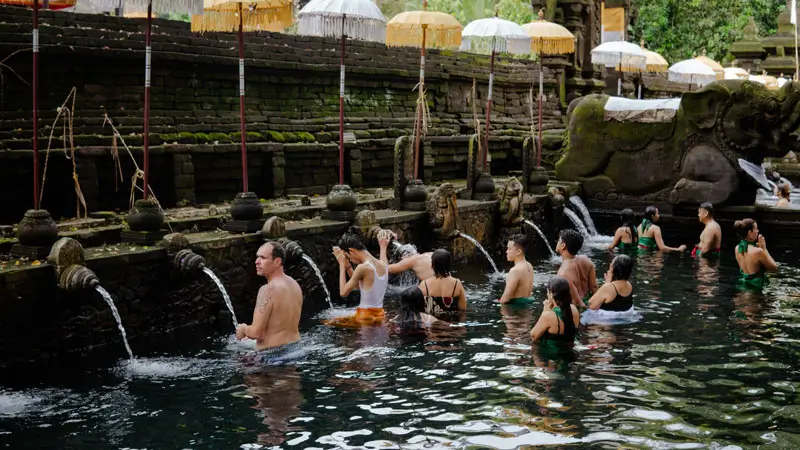
- Purnama (Full Moon) & Tilem (New Moon): Ideal for spiritual cleansing.
- Kajeng Kliwon: A special purification day in Balinese tradition.
Tip: These dates attract more visitors, so arrive early to avoid long queues.
Best Time for Cultural Ceremonies
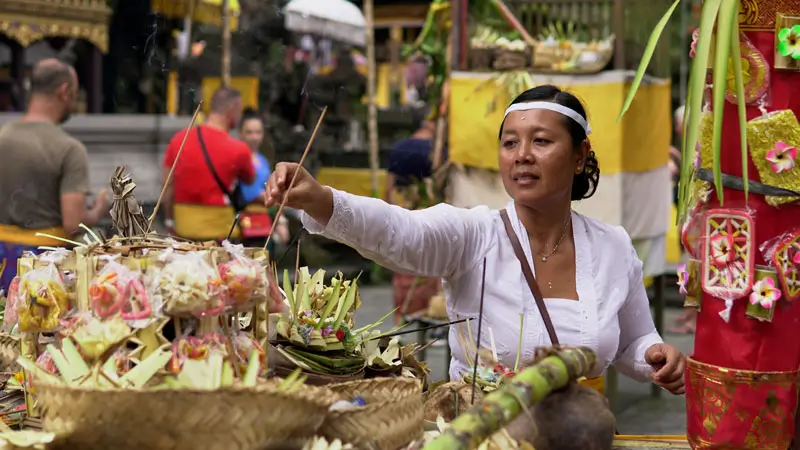
- Galungan & Kuningan: A major Balinese festival celebrating the triumph of good over evil.
- Piodalan (Temple Anniversary): The temple’s most sacred celebration with prayers and processions.
Expect Large crowds, vibrant cultural performances, and a deeply spiritual atmosphere.
Planning a Bali trip? Check out this guide: “Best Time to Travel in Bali.”
Where is Tirta Empul Temple, Bali, Located?
Tirta Empul Temple is in Manukaya Village, within the Tampaksiring District of Gianyar, Bali. It is approximately 36 km from Denpasar, making it a manageable day-trip destination.
Since there is no direct public transportation, the best way to get there is by private vehicle or rental transport, which is smoother and more comfortable.
Estimated Travel Time from Popular Areas
| Departure Location | Approximate Travel Time |
|---|---|
| Ubud | ± 40 minutes |
| Kuta & Seminyak | ± 1.5 hours |
| Ngurah Rai Airport | ± 1.5 hours |
Best Ways to Reach Balinese Bathing Temple
To help you choose the most convenient option, here are the best ways to get there:
- Google Maps Navigation: To get accurate directions, simply enter “Pura Tirta Empul, Tampaksiring, Gianyar, Bali.” Some routes pass through traditional villages and narrow roads, so drive cautiously.
- Rent a Scooter – This option is great for solo travelers or couples who prefer flexible exploration.
- Hire a Car with a Driver – Great for families or small groups who want a comfortable and easy ride.
- Join a Tour Package – This is the most convenient choice, as it often includes transportation, entrance fees, and a guide.
Whether you’re considering renting a scooter, hiring a private driver, or using ride-hailing apps, our Complete Guide to Getting Around Bali covers everything you need to navigate the island easily.
How Much Time Do You Need at Tirta Empul Temple?
The average visit to Tirta Empul Temple, Bali, ranges from 30 minutes to 2 hours, depending on your activities.
Recommended Visit Duration
- Sightseeing & Photography – 30–60 minutes to explore the temple grounds, admire the holy spring pools, and appreciate Balinese architecture.
- Melukat Purification Ritual – 1.5–2 hours, including changing into a sarong, performing the ritual, and praying at the shrines.
- During Festivals and peak Hours, expect a longer wait, as Melukat participation is limited to 30 people at a time.
Best Tip: Arrive by 08 AM for a peaceful visit and to join the purification ritual.
Helpful Guide for Visitors to Holy Spring Water Temple
Before heading to Tirta Empul Temple in Tampaksiring, knowing a few key details will make your visit smooth and enjoyable.
Bali Water Temple Operating Hours
| Day | Operating Hours |
|---|---|
| Every Day | 08:00 – 18:00 WITA |
| For Hindu Worshippers | Open 24 hours |
| Nyepi (Day of Silence) | Closed |
How Much Does It Cost to Visit Tirta Empul Temple, Bali?
As of January 1, 2025, the entrance fee for Tirta Empul Temple is:
| Category | Ticket Price |
|---|---|
| Adults | Rp 75,000/person |
| Children (5-12 years) | Rp 50,000/person |
| Children under 5 years old | Free entry |
For the most up-to-date information on entry fees, locker rentals, and parking costs, check out our Tirta Empul Entrance Fee Guide, which provides a complete breakdown of pricing and essential visitor details.
Important Notes for Visitors
- Sarong and Shawl Rental: These are required for entry, but don’t worry—they’re included in your ticket price.
- Cash-Only Payments: Credit/debit cards aren’t accepted, so bring enough local currency.
- Buy Tickets at the Official Counter: Avoid unofficial sellers outside the temple.
Dress Code and Etiquette at Holy Spring Water Temple
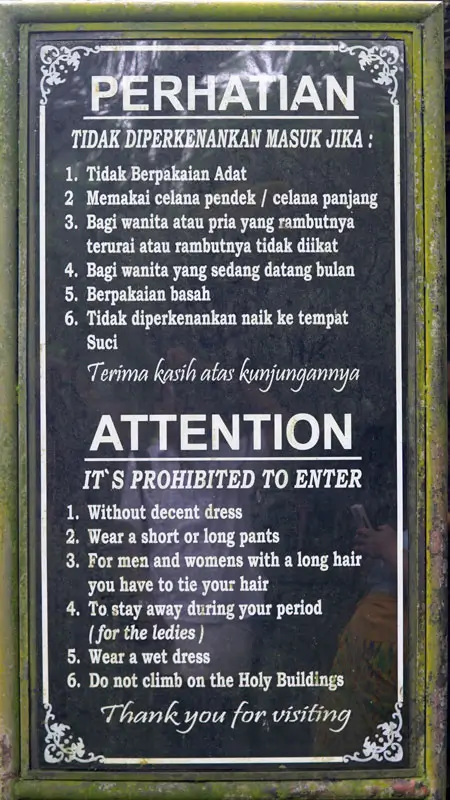
What to Wear for Tirta Empul Temple Tampaksiring?
All visitors must wear a Kamen (sarong) and sash as a sign of respect. These are provided for free at the entrance. Additionally:
- Sarong & Sash – Required for entry (available at the entrance).
- Covered Shoulders – Avoid tank tops or revealing clothing.
- Udeng (Traditional Headband for Men) – Optional but adds to the cultural experience.
Tip: If you don’t have a sarong, you can borrow one for free at the entrance—it’s included in the ticket price.
Before visiting Tirta Empul or any other temple in Bali, learn more about what to wear in our Complete Guide to Temple Dress Code in Bali.
Temple Etiquette & Prohibited Actions
As a sacred Hindu temple, Tirta Empul Bali requires visitors to observe proper etiquette:
- Respect Sacred Spaces – Do not step on altars or holy structures.
- Women During Menstruation – Not permitted to enter the main temple area, as per Hindu customs.
- Keep Conversations Polite – Avoid loud or disruptive behavior.
- Maintain Cleanliness – Use trash bins; do not litter or spit.
Facilities at Balinese Bathing Temple
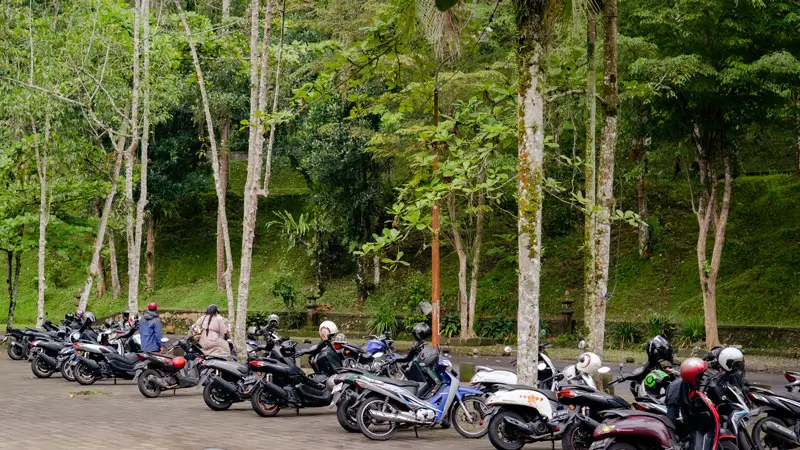
Tirta Empul Temple Tampaksiring provides several facilities, especially for those participating in the Melukat purification ritual:
- Spacious parking area – Conveniently located near the temple entrance.
- Toilets & changing rooms – Available for those joining the Melukat ritual.
- Locker rentals – Safely store your valuables.
- Souvenir stalls – Purchase sarongs, scarves, and udeng headbands as traditional Balinese souvenirs.
- Food stalls – Enjoy local dishes after your temple visit.
Tip: Many shops and stalls only accept cash, so bring enough local currency.
Photography Tips at Sacred Water Temple
Best Photo Spots at Purification Temple
Want to capture the beauty of Tirta Empul? Here are the best spots for stunning photos:
- Main Gate – With its intricate Balinese carvings, this entrance makes an excellent backdrop for a well-framed shot.
- Holy Water Fountains – Snap a picture when the sunlight reflects off the flowing water—it creates a peaceful and almost mystical effect.
- Outer Temple Area – An excellent place for wide-angle shots, with lush greenery and ancient temple structures adding to the scenery.
Photography Etiquette
- Respect Worshippers – Avoid taking close-up shots of people praying or performing rituals.
- Use Natural Light – Visit in the morning or late afternoon for soft, natural lighting.
- Maintain Distance – Be mindful of personal space and avoid blocking religious ceremonies.
History, Legends, and Religious Traditions at Tirta Empul Temple
What is the legend behind the Holy Spring Water Temple?
Tirta Empul Temple is closely tied to the legend of King Mayadenawa and Lord Indra, a Balinese myth that symbolizes divine justice and spiritual renewal.
According to the story (Source: Wikipedia.org), Mayadenawa was a tyrannical king who banned religious worship and desecrated temples. In response, Lord Indra descended to restore balance and confront him.
The Birth of Tirta Empul’s Sacred Spring
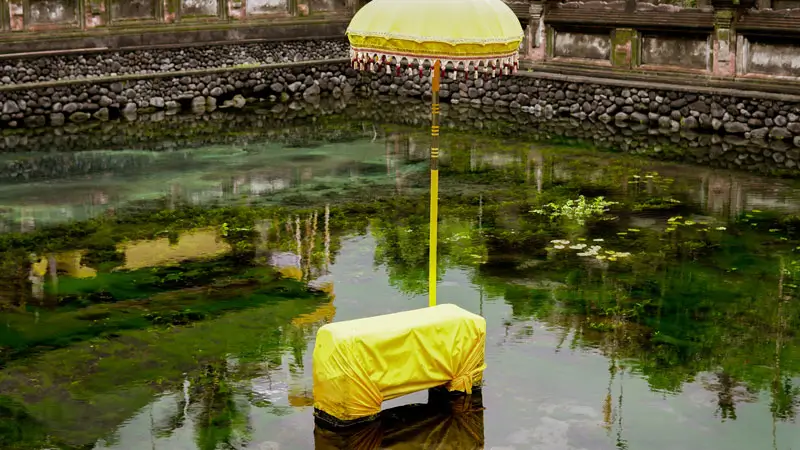
Mayadenawa poisoned a water source to weaken Indra’s warriors. In response, Indra created Tirta Empul, a sacred spring with healing water, which restored his troops and led them to defeat Mayadenawa.
As the defeated king fled, he walked sideways to avoid leaving footprints. However, he was eventually captured. Interestingly, this escape attempt is named the area Tampaksiring, which means “tilted footsteps” in Balinese.
Fun Fact: If you’re already visiting Tirta Empul bali, consider taking a short drive to Gunung Kawi Temple—a breathtaking site known for its ancient stone reliefs and peaceful temple complex. Check out our Gunung Kawi Temple Travel Guide to explore its history, entrance fees, and the best way to visit this hidden gem in Bali!
When was the Tirta Empul Temple built?
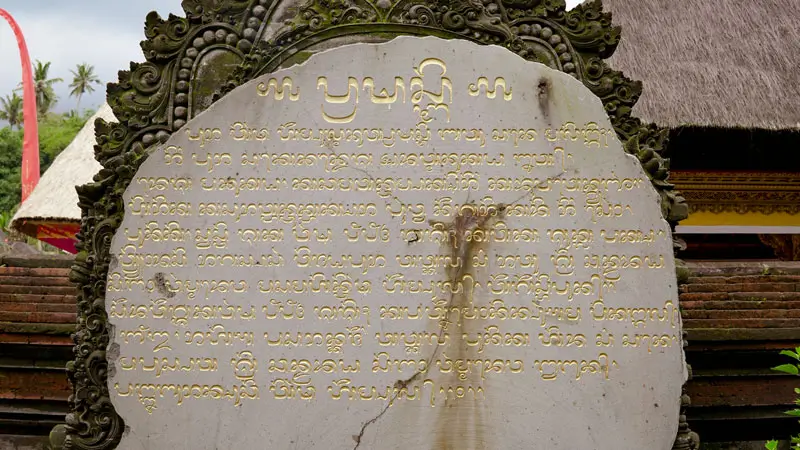
Tirta Empul Temple, Bali, was built in 962 AD, during King Sri Candrabhayasingha Warmadewa’s rule of the Warmadewa Dynasty. Dedicated to Vishnu, the Hindu god of water, this over 1,000-year-old temple is primarily known for its sacred spring, which is believed to have divine purification powers.
Even today, this sacred spring attracts Hindu pilgrims and travelers seeking spiritual cleansing. Due to its profound historical and religious importance, Tirta Empul remains one of Bali’s most significant holy sites.
Interested in exploring more sacred temples? Then don’t miss Besakih Temple—Bali’s most important Hindu temple, often called the ‘Mother Temple’ of the island. Learn more about its history, religious significance, and visitor tips in our Besakih Temple Guide to plan your visit easily.
Tirta Empul Bathing Temple FAQ: Your Questions Answered
Are you planning a visit? Here are answers to some common questions about the Melukat ritual, temple facilities, and special events.
1. Do I need to pay extra for the Melukat ritual?
No, there’s no additional fee to join the Melukat purification ritual. However, it’s customary to:
- Give a voluntary donation to help maintain the temple.
- Purchase a canang sari offering (available at temple stalls).
2. Can I take home holy water from Tirta Empul?
Yes, but with respect for temple traditions. Here’s how:
- Ask permission from the temple staff.
- Use a small bottle—avoid taking large amounts.
Tip: Many local people think that water has special blessings, which makes it essential for them to bring it home.
3. Is there an age limit for the Melukat ritual?
No, anyone can participate, but:
- Parents should supervise children.
- Avoid letting kids play in the holy pool, as it’s a sacred space for purification.
Tip: Wearing a light swimsuit under your sarong makes the experience more comfortable.
4. Is Tirta Empul accessible for older travelers or visitors with disabilities?
The temple itself is accessible for older people, but the Melukat pools require stepping into the water and are not wheelchair-friendly.
Advice: Bring a companion or ask temple staff for help if you need assistance.
5. When is the best time to visit Tirta Empul for the Piodalan ceremony?
The Piodalan ceremony (the temple’s anniversary) occurs once a year on the Fourth Full Moon, which in 2025 falls on October 6.
Why visit during Piodalan? You’ll witness authentic Balinese Hindu rituals, temple processions, and a deeply spiritual atmosphere.
Cultural Destinations Near Holy Spring Water Temple
Want to explore Bali’s culture more? Here are two must-visit spots nearby:
- Penglipuran Village – A traditional Balinese village famous for its well-preserved architecture and cultural charm.
- Tegalalang Rice Terrace – A breathtaking landscape of lush, terraced rice fields.
Tip: You can visit both on the same trip after exploring Tirta Empul Temple!
Why is Tirta Empul Temple a Must-Visit in Bali?
Whether you’re drawn to Tirta Empul for its sacred Melukat purification ritual, stunning Hindu architecture, or peaceful atmosphere, this temple in Bali offers a truly unforgettable experience.
Don’t just read about it—experience the spiritual energy of Tirta Empul for yourself! Plan your visit today and book a guided tour with us. Enjoy a simple journey while learning about Balinese Hindu traditions from our experts.
If you’re fascinated by Bali’s rich spiritual heritage, don’t stop at Tirta Empul! Discover the island’s most breathtaking and culturally significant temples in our Bali’s Must-Visit Temples: A Guide to the Island’s 10 Sacred Wonders and plan your ultimate temple-hopping adventure.
Notice:
Photo Copyright: Wira Tour Bali copyrights all photos in this article. Unauthorized use, duplication, or distribution without written permission is strictly prohibited.
Bahasa Indonesia: “Tempat Wisata Pura Tirta Empul Bali“.

 Uluwatu Temple Bali [2025] Travel Guide: Tips and Must-See Highlights
Uluwatu Temple Bali [2025] Travel Guide: Tips and Must-See Highlights
We'd love to hear from you! Share your thoughts or experiences in the comments below!